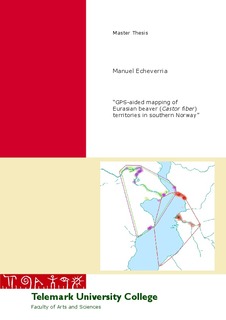| dc.contributor.author | Echeverria, Manuel | |
| dc.coverage.spatial | Telemark | |
| dc.date.accessioned | 2015-03-09T10:45:49Z | |
| dc.date.accessioned | 2017-04-19T13:13:35Z | |
| dc.date.available | 2015-03-09T10:45:49Z | |
| dc.date.available | 2017-04-19T13:13:35Z | |
| dc.date.issued | 2014 | |
| dc.identifier.citation | Echeverria, M. GPS-aided mapping of Eurasian beaver (Castor fiber) territories in southern Norway. Master thesis, Telemark University College, 2014 | |
| dc.identifier.uri | http://hdl.handle.net/11250/2438902 | |
| dc.description.abstract | In this study I use GPS technology for the first time on the monogamous semi-aquatic Eurasian Beaver (Castor fiber). I tested the hypothesis that GPS technology can be used in the riparian environment. Further I tested the hypothesis that beavers do not show sexual behavioural dimorphism by measuring territory size, distance travelled and activity patterns. I also predict that overlapping of territories will be located at the borders. I attached GPS tags on 18 dominant individuals ( ± SD weights) males (23.0 ± 1.1 kg) and females(24.0 ± 2.3 kg), and 4 subordinates (males= 15.2 ± 1.7; females= 18.7 ± 5.3) in Telemark county, southern Norway. GPS tags were deployed for 12.7 ± 4.3 (7 ??24) days with a sampling rate of 15 minutes from 19:00 to 7:00 resulting in 443± 41.1(190??811) locations per animal, during the months of April to October from 2009 to 2011. I calculated territory sizes by measuring 95% and 50% cores by using two different Home range estimators; the Minimum Convex Polygons (MCPs) and Kernel Density Estimator (KDE). Further with the resulting polygon from the MCPs I calculated territory sizes as river bank length. The measurements for the 95% cores showed no significant differences between the estimators. The 50% cores measurements showed significant differences indicating greater accuracy for the KDE. My results suggest that beavers do not show sexual behavioural dimorphism in activity, territory size and distance travelled. Territory overlap between neighbours resulted in 7.4% ± 7.4% (0.05 ??31.2%) for KDE measurements and 15.5%± 15.1%(0.03??43.2%) for MCPs, overlap occurred only at the 95% cores corroborating the hypothesis. Mated pairs(N = 3) overlap resulted for MCPs 88.4± 11.1% and KDE 84.1 ± 5.3% showing that they shared the same territories, supporting the hypothesis that Eurasian beavers are a strictly monogamous species. GPS technology allowed beaver territories to be defined with high precision, providing a better understanding of the spatial behavior and activity of beavers and greatly reducing tracking efforts and costs. | |
| dc.language.iso | eng | |
| dc.publisher | Høgskolen i Telemark | |
| dc.subject | beavers | |
| dc.subject | Castor fiber | |
| dc.subject | activity | |
| dc.subject | behaviour | |
| dc.subject | GPS | |
| dc.subject | nightly distance travelled | |
| dc.subject | territory | |
| dc.title | GPS-aided mapping of Eurasian beaver (Castor fiber) territories in southern Norway | |
| dc.type | Master thesis | |
| dc.description.version | Published version | |
| dc.rights.holder | © Copyright The Author. All rights reserved | |
